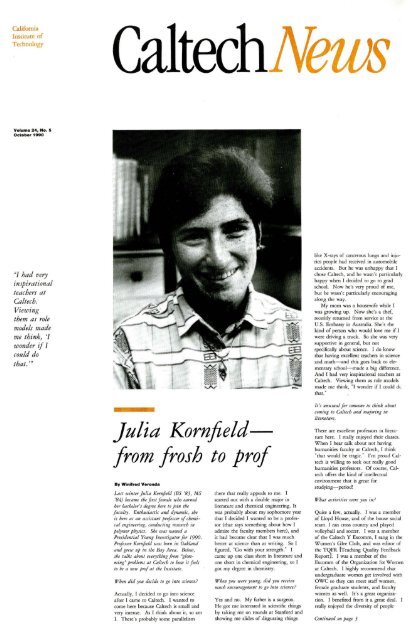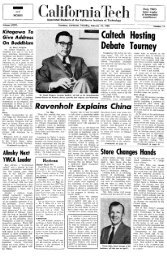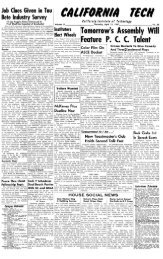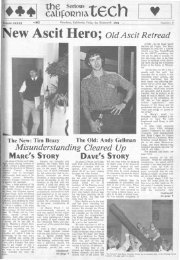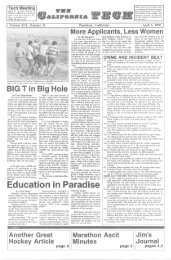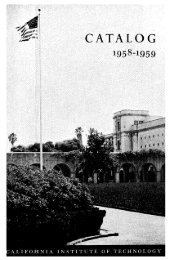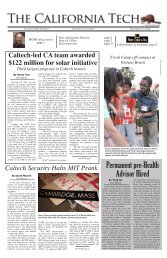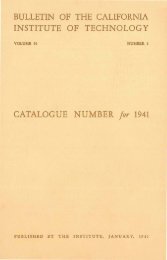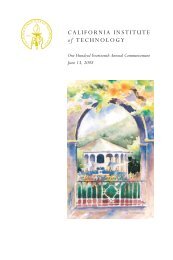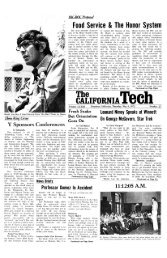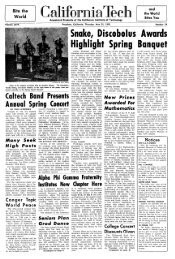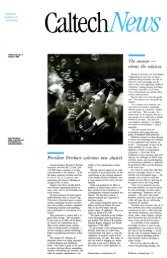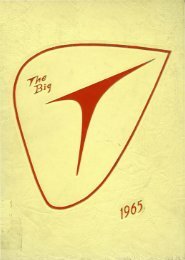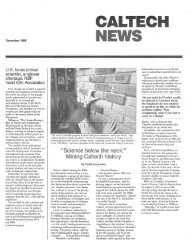Julia Kornfield- - CaltechCampusPubs - California Institute of ...
Julia Kornfield- - CaltechCampusPubs - California Institute of ...
Julia Kornfield- - CaltechCampusPubs - California Institute of ...
You also want an ePaper? Increase the reach of your titles
YUMPU automatically turns print PDFs into web optimized ePapers that Google loves.
<strong>California</strong><br />
<strong>Institute</strong> <strong>of</strong><br />
Technology<br />
Volume 24, No.5<br />
October 1990<br />
"[ had very<br />
inspirational<br />
teachers at<br />
Caltech,<br />
Viewing<br />
them as role<br />
models made<br />
me think, '[<br />
wonder if [<br />
could do<br />
that, ,n<br />
<strong>Julia</strong> <strong>Kornfield</strong><br />
from frosh to pr<strong>of</strong><br />
By Winifred Veronda<br />
La.rt winter <strong>Julia</strong> <strong>Kornfield</strong> (BS '83, MS<br />
'84) became the first female who earned<br />
her bachelor's degree here 10 Join the<br />
familY. Enthllsiastic and dynamic, she<br />
is here as an assistant py<strong>of</strong>essor <strong>of</strong> chemical<br />
CIIgineering, condllcting research in<br />
polymer physic.r. She was named a<br />
Pmidenlial Young Investigator for 1990.<br />
Pr<strong>of</strong>essor <strong>Kornfield</strong> was born in Oakland<br />
and grew tip in Ihe Bay Area. Below,<br />
she talks abolll everything from "glomming"<br />
problems at Caltech to how it jeelJ<br />
to be a new pr<strong>of</strong> at the Institllte.<br />
When did YOIt decide to go into science?<br />
Actually, I decided ro go into science<br />
after I came to Cal tech. I wanted to<br />
come here because Cal tech is small and<br />
very intense. As I think about it, so am<br />
I. There's probably some parallelism<br />
there that really appeals to me. I<br />
started out with a double major in<br />
literature and chemical engineering. It<br />
was probably about my sophomore year<br />
that I decided r wanted to be a pr<strong>of</strong>essor<br />
(that says something about how I<br />
admire the faculty members here), and<br />
it had become clear that I was much<br />
better at science than at writing. So I<br />
figured, "Go with your strength: I<br />
came up one class short in literature and<br />
one short in chemical engineering, so I<br />
gOt my degree in chemistry.<br />
When yolt were young, did YOll receive<br />
much encouragement to go into sciem'e?<br />
Yes and no. My father is a surgeon.<br />
He got me interested in scientific rhings<br />
by taking me on rounds at Stanford and<br />
showing me slides <strong>of</strong> disgusting things<br />
like X-rays <strong>of</strong> cancerous lungs and injuries<br />
people had received in automobile<br />
accidents. But he was unhappy that I<br />
chose Caltech, and he wasn't particularly<br />
happy when 1 decided to go ro grad<br />
school. Now he's very proud <strong>of</strong> me,<br />
bur he wasn't particularly encouraging<br />
along the way.<br />
My mom was a housewife while 1<br />
was growing up. Now she's a chef,<br />
recently returned from service at the<br />
U.S. Embassy in Australia. She's the<br />
kind <strong>of</strong> person who would love me if 1<br />
were driving a truck. So she was very<br />
supportive in general, bur not<br />
specifically about science. I do know<br />
that having excellent teachers in science<br />
and math- and this goes back ro elementary<br />
school-made a big difference.<br />
And I had very inspirational teachers at<br />
Cal tech. Viewing them as role models<br />
made me think, "I wonder if I could dl.<br />
that. "<br />
It's tmltJlial for someone to think aboul<br />
coming to Caltech and majoring in<br />
literalflre.<br />
There are excellent pr<strong>of</strong>essors in literature<br />
here. I really enjoyed their classes.<br />
When I hear talk abour not having<br />
humanities faculty at Caltech, I think<br />
"that would be tragic: I'm proud Caltech<br />
is willing to seek our really good<br />
humanities pr<strong>of</strong>essors. Of course, Caltech<br />
<strong>of</strong>fers the kind <strong>of</strong> intellectual<br />
environment that is great for<br />
studying-period!<br />
What activities were you in?<br />
Quite a few, actually. I was a member<br />
<strong>of</strong> Lloyd House, and <strong>of</strong> the house social<br />
team. I ran cross country and played<br />
volleyball and soccer. I was a member<br />
<strong>of</strong> the Caltech Y Excomm, I sang in the<br />
Women's Glee Club, and was ediror <strong>of</strong><br />
the TQFR [Teaching Quality Feedback<br />
Reportl. I was a member <strong>of</strong> the<br />
Excomm <strong>of</strong> the Organization for Women<br />
at Caltech. I highly recommend that<br />
undergraduate women get involved with<br />
OWC so they can meet staff women,<br />
female graduate students, and faculty<br />
women as well. It's a great organization.<br />
I benefited from it a great deal.<br />
really enjoyed the diversity <strong>of</strong> people<br />
Continued on jJage 3
<strong>Kornfield</strong><br />
Continlled from page 1<br />
that I met through these activities. I did<br />
a lot, and I would recommend that (0<br />
any student. I think I was a bit overextended,<br />
but my grades were okay. I<br />
managed (0 graduate with honor.<br />
Did YOll receive any awards?<br />
I received the Haagen-Smit Award (0<br />
the outstanding junior chemistry srudemo<br />
I believe that's all.<br />
WaJ' "glomming" a problem for YOll?<br />
(Ed. note: Glomming iJ done by trJetie<br />
JtlldentJ who hang around female Jtudents,<br />
seeking their Stlpport and sympathy,)<br />
In the beginning, but I developed coping<br />
mechanisms. This was difficult,<br />
though, because it made me somewhat<br />
callous. It's hard, having (0 push people<br />
away and say, "Hey, I have (0 take<br />
care <strong>of</strong> my own life (00, you know,"<br />
and, "You'te the tenth guy (Oday who's<br />
wanted (0 cry on my shoulder. Sorry.<br />
Get out." It's easier (0 make decisions<br />
about how much time you'll spend with<br />
sports or cooking, than it is to say no to<br />
somebody who clearly wams you to talk<br />
to him.<br />
It's expected hete that the female<br />
students will do all the caretaking. But<br />
men need to face rhe fact that they have<br />
(0 help each other, too. I'm sure that,<br />
if men look inside themselves, they can<br />
be just as caring as women can. It's not<br />
that they aren't concerned abour their<br />
classmates. But they're programmed (0<br />
only look (0 women for supporr. And<br />
in an environment like this, there just<br />
aren't enough women to support themselves<br />
and evetyone else.<br />
Did YOII ever have any regrets abollt<br />
coming to Caltah?<br />
No, bur as an alumna I've done tecruiting<br />
for admissions, and I'm cautious<br />
about recommending Cal tech because <strong>of</strong><br />
the number <strong>of</strong> students I saw who really<br />
suffered. I was lucky enough to be in<br />
the upper half <strong>of</strong> the class somewhere.<br />
But the students who were in the lower<br />
30 percent probably felt miserable most<br />
<strong>of</strong> the time.<br />
I feel it's a disadvantage to be at<br />
Cal tech if you're going to be in that<br />
bracket, because if you were at Stanford<br />
you'd be at the top <strong>of</strong> the class. And<br />
unless you can hack the pain <strong>of</strong> being<br />
toward the bottom and still go on to<br />
make a successful career, I don't think<br />
you should come here.<br />
What do you tell the students who YOll<br />
think shou/cl not apply?<br />
It's usually enough to tell them what<br />
the admission requirements are and<br />
what the class composition is. That<br />
intimidates most <strong>of</strong> the people who feel<br />
they could nOt make the top half,<br />
without the need to say anything more,<br />
I think one <strong>of</strong> the things that's really<br />
important fot Caltech to do is to provide<br />
a transition for freshmen who realize<br />
they're really struggling, to help<br />
them transfer to another good college.<br />
It's important for the students On the<br />
lower rung hete to realize that they are<br />
still very good. They should go to a<br />
place where they can have that perspective<br />
about themselves, instead <strong>of</strong> staying<br />
here where they kind <strong>of</strong> wither.<br />
What teachers do you feel were especially<br />
influential?<br />
I'm going to get into trouble here<br />
because I can't name everybody that I'd<br />
tiness when he died.<br />
In my freshman year I also took Pr<strong>of</strong>essor<br />
Ray Owen's introductory biology<br />
course, He is so attentive and so<br />
encouraging that srudents naturally<br />
gravitate to him. I was nO exception,<br />
and he remains one <strong>of</strong> my role models<br />
as a teacher and mentor. In chemical<br />
engineering, twO <strong>of</strong> my favorite pr<strong>of</strong>essors,<br />
Greg Stephanopoulos and Eric<br />
Herbolzheimer, aren't here any more.<br />
Another favorite is George Gavalas. He<br />
teaches a great sophomore thermodynamics<br />
class.<br />
I know the pr<strong>of</strong>essors who are really<br />
inspirational put in a lot <strong>of</strong> extra time.<br />
I definitely want to develop into one <strong>of</strong><br />
those because I really appreciate what<br />
they did for me when I was here.<br />
You went to Stanford for your PhD.<br />
How was it, being at Stanford after six<br />
years at Caltech?<br />
Graduate students Axel Kratel (seated), Guen-Chang Chung, and Kannan<br />
Ragaramanujom share a laugh with <strong>Kornfield</strong> in her lab.<br />
like to mention, but the first name that<br />
leaps to mind is Pr<strong>of</strong>essor Peter Dervan,<br />
who teaches an outstanding organic<br />
chemistry class.<br />
Something that was really great was<br />
the way freshman physics was run; all<br />
the sections were led by pr<strong>of</strong>essors.<br />
There I gOt in touch with Pr<strong>of</strong>essor Jerry<br />
Pine, who's really an inspirational<br />
teacher and a live wire, and that led to<br />
my doing a SURF [Summer<br />
Undergraduate Research Fellowship I<br />
with him. His recitation section grew to<br />
overflowing, and he encouraged me to<br />
transfer into a much smaller section led<br />
by a rather intimidating pr<strong>of</strong>essor, Max<br />
Delbruck. Studying in Pr<strong>of</strong>essor<br />
Delbruck's section turned out to be a<br />
wonderful, inspiring experience. He<br />
forced uS to show each other our solutions<br />
at the board without our notes,<br />
and was very harsh when we disappointed<br />
him. Bur he could be very<br />
warm and funny. At that time he was<br />
facing death with great courage, and I<br />
felt a terrible sense <strong>of</strong> sadness and emp-<br />
In my graduate class in chemical<br />
engineering, the students were from the<br />
best schools. Because they were admitted<br />
to Stanford, I'm sure they were at<br />
the top in their colleges and universities,<br />
and I bet they were as smart as I was.<br />
But they were struggling in the classroom<br />
at Stanford, and I was having the<br />
experience for the first time <strong>of</strong> completing<br />
every problem on the problem sets<br />
and getting 100s on the exams. I had<br />
spare time to play rugby and soccer and<br />
lift weights and do cycling. And I took<br />
some humanities classes. I was shocked<br />
at how easy it seemed there after having<br />
been here. When I was a student here,<br />
we always heard people saying, "You'll<br />
see after you leave here. You'll find out<br />
that you got training that was really<br />
ahead <strong>of</strong> the rest." And I would say,<br />
"Oh, baloney. You guys are JUSt<br />
egomaniacs; you think Caltech is so<br />
great. I'm sure Berkeley and MIT are<br />
JUSt as good."<br />
But then you go out and you discover<br />
that what they said was true. I<br />
don't want to sound like a snob, but I<br />
was extremely well prepared by Cal tech,<br />
and I'm eternally grateful.<br />
What made you decide to come back to<br />
Calteeh?<br />
It was an extremely hard decision. Caltech<br />
is a really great place, but I didn't<br />
know if I'd be happy here. Among<br />
other things, I worshiped the faculty so<br />
I figured there was no way I could be<br />
good enough to measure up to them,<br />
and I thought I'd constantly feel under<br />
terrible pressure. I almost persuaded<br />
myself not to come. I guess what eventually<br />
did convince me to come back<br />
was that I knew how well Cal tech takes<br />
care <strong>of</strong> its faculty. Now that I've been<br />
here a few months, I see that it is even<br />
better than I realized.<br />
The most obvious advantage to coming<br />
here is the qualiry <strong>of</strong> the graduate<br />
srudents, compared even to those at a<br />
place like Stanford, which is a really,<br />
really good place. But Caltech admits a<br />
smaller class and we get the very top <strong>of</strong><br />
tbe student pool. So the graduate students<br />
here are better than those at Stanford<br />
or MIT or any other first-rate<br />
school.<br />
That fact was the overriding factor<br />
that convinced me to come back to Caltech,<br />
in spite <strong>of</strong> my fears. Then, after<br />
getting here, I found that the faculry<br />
really treat you with respect and<br />
confidence. You get the feeling, "They<br />
believe in me and they've been around<br />
awhile. "<br />
Over the past few months tbeir attirude<br />
has built my confidence up to<br />
where I think, "Well, I may not get<br />
tenure, bur I'm not going to worry<br />
about it every nighr. So I'll JUSt keep<br />
working at it and we'll see how it turns<br />
out." So it's not as stressful as I<br />
thought it would be.<br />
U'/hal's your reJearch area?<br />
1'm working in polymer physics. Polymers<br />
are large chain-like molecules that<br />
we use in a huge variery <strong>of</strong> things like<br />
counter tops, compact disks, and the<br />
casings <strong>of</strong> your tape cassettes, and my<br />
computer, The aspect that I'm most<br />
interested in is how the molecular<br />
motions within a polymer will affect<br />
how it flows during processing and what<br />
kinds <strong>of</strong> properties it has when something<br />
has been made out <strong>of</strong> it, how the<br />
microstructure is affected by processing,<br />
and how that controls the macroscopic<br />
properties <strong>of</strong> some article that we've<br />
made.<br />
Do YOll have any graduale J/lldenlJ?<br />
I'm so lucky! I have tbree graduate Students!<br />
For only having been here since<br />
January, that's terrific! Two <strong>of</strong> them are<br />
first-year chemical engineering grad uate<br />
students, and one is a second-year physics<br />
graduate student. They're really<br />
bright and motivated, so I'm <strong>of</strong>f to a<br />
Continl/ed on page 10<br />
3
4<br />
FRIENDS<br />
An update on<br />
sponsored research<br />
Every year, Caltech is the beneficiary<br />
<strong>of</strong> many millions <strong>of</strong> dollars in federal<br />
funds to support research and development.<br />
This crucial funding makes up<br />
46 percent <strong>of</strong> the <strong>Institute</strong>'s total<br />
budget in the 1990 fiscal year.<br />
The most recent year for which<br />
National Science Foundation statistics on<br />
federal agenc), obligations (money allocated)<br />
to institutions <strong>of</strong> higher education<br />
are available is 1988. That year Caltech<br />
was the beneficiary <strong>of</strong> obligations <strong>of</strong><br />
$70,489,000. Funds came from a cluster<br />
<strong>of</strong> agencies, with the NSF leading<br />
the contingent <strong>of</strong> benefactors.<br />
For 1988, NSF was the solltce <strong>of</strong><br />
$24,991 ,000, or roughly 35 percent <strong>of</strong><br />
all federal funding obligations to Caltech.<br />
The other agencies which listed<br />
obligations to the <strong>Institute</strong> include the<br />
Department <strong>of</strong> Health and Human Services,<br />
largely thtough the National <strong>Institute</strong>s<br />
<strong>of</strong> Health ($15,294,000), the<br />
Department <strong>of</strong> Defense ($11,2.')5,000),<br />
NASA ($7,893,000), the Department<br />
<strong>of</strong> Energy ($9,124,000), the Department<br />
<strong>of</strong> the Interior ($1,448,000), the<br />
Environmental Protection Agency<br />
($423,000), and the Department <strong>of</strong><br />
Commerce ($90,000).<br />
The largest a ward for this fiscal year<br />
is $4,175,000 ftom the Department <strong>of</strong><br />
Energy to suppOrt high-energy physics<br />
research under the direction <strong>of</strong> Barry C.<br />
Barish, pr<strong>of</strong>essor <strong>of</strong> physics. These<br />
funds are in the form <strong>of</strong> an ongoing<br />
contract. Second largest is a<br />
$3,430,000 grant for Letoy E. Hood,<br />
the Ethel Wilson Bowles and Robert<br />
Bowles Pr<strong>of</strong>essor <strong>of</strong> Biology, and director<br />
<strong>of</strong> the Center for the Development<br />
<strong>of</strong> an Integrated Protein and Nucleic<br />
Acid Biotechnology, one <strong>of</strong> 11 NSF<br />
Science and Technology Centers in the<br />
COUntry.<br />
Hot research topics vary as the years<br />
go by, and funding tends to follow<br />
trends. Among the big winners in<br />
1990 are biotechnology, particularly<br />
research related to the mapping <strong>of</strong> the<br />
human genome, and ultra-high-speed<br />
computing, particularly parallel processing.<br />
"Superconductiviry is another topic<br />
that's being funded well: says Earl<br />
Freise, director <strong>of</strong> sponsored research.<br />
New materials research is also a funding<br />
prioriry, although Caltech's breadth in<br />
this field is limited.<br />
Freise finds that the political climate<br />
under the Bush administration has not<br />
changed significantly from that <strong>of</strong> the<br />
Reagan years. "The key words that we<br />
hear have to do with keeping the U.S.<br />
competitive and at the leading edge in<br />
science and technology," he says. "I<br />
don't think Bush has changed any <strong>of</strong><br />
that. This is exemplified by the fact<br />
that he's pushing the space station and<br />
he's supportive <strong>of</strong> the superconducting<br />
supetcollider, as well as the project to<br />
map the human genome. All these projects<br />
are continuing under this administration.<br />
'<br />
How does Caltech rank in federal<br />
dollars received in comparison with<br />
othet institutions? Among the top 100<br />
schools, Caltech has ranked consistently<br />
among the top 20 or 30 in terms <strong>of</strong><br />
federal funding. Most other schools<br />
which rank higher have much larger<br />
facilities and tend to be broader in scope<br />
than Caltech, i.e., state land-grant colleges<br />
with substantial funding for agricultural<br />
tesearch or universities with<br />
large medical schools.<br />
Over the years, the percentage <strong>of</strong><br />
Caltech's budget coming from the<br />
federal government has remained relatively<br />
consistent, according to director <strong>of</strong><br />
finance and controller Harold Bell. In<br />
1976 and again in 1981, the percentage<br />
was 49 percent. In 1986, it was 43<br />
percent, and in 1990, 46 percent.<br />
Federal suppon for Cal tech has<br />
increased over the last 10 years in actual<br />
dollars, Freise notes, but in real dollars<br />
the amount is probably about the same.<br />
Even if federal dollars for research<br />
funding should shrink, Freise feels that<br />
Cal tech will always be in a stronger<br />
position than most universities, because<br />
<strong>of</strong> its reputation and the quality <strong>of</strong> its<br />
faculty. "Caltech gets 1 percent <strong>of</strong> all<br />
federal dollars expended for research.<br />
That's really quite good for an institution<br />
our size,' he says. "The quality<br />
and aggressiveness <strong>of</strong> our faculty keeps<br />
us competitive. We'll continue to get a<br />
good share <strong>of</strong> rhe funds."<br />
Annual report<br />
copies available<br />
A limited number <strong>of</strong> copies <strong>of</strong> the<br />
Caltech 1988-89 annual repon are<br />
available rhrough the public relations<br />
<strong>of</strong>fice. Contact Debbie Bradbury, 1-71,<br />
Calrech, Pasadena, <strong>California</strong> 91125, or<br />
call (818) 356-3630.<br />
Kieschnicks make<br />
gift <strong>of</strong> $1 million<br />
Caltech Ttustee William F. Kieschnick<br />
and his wife, Keith, have made a<br />
$1 million gift to Caltech for its upcoming<br />
fund-raising campaign, Caltech<br />
Presidenr Thomas E. Everhart has<br />
announced. The gift, in the form <strong>of</strong> a<br />
charitable trust, is unrestricted, and the<br />
funds may be used at the <strong>Institute</strong>'s<br />
discretion.<br />
"Weare pr<strong>of</strong>oundly grateful for this<br />
generous leadership gift, which is especially<br />
timely as the <strong>Institute</strong> prepares to<br />
begin its cenrennial year in 1991," said<br />
President Everhan.<br />
The Kieschnicks have made their gift<br />
in anticipation <strong>of</strong> the <strong>Institute</strong>'s campaign,<br />
which will be launched in<br />
March 1991 in conjunction with the<br />
Caltech cenrennial. "Keith and I believe<br />
strongly in giving unrestricted funds,"<br />
said Kieschnick. "We are confident that<br />
the <strong>Institute</strong> will put our gift to the best<br />
possible use."<br />
William Kieschnick is the retired<br />
president and chief executive <strong>of</strong>ficer <strong>of</strong><br />
the Atlantic Richfield Company, a company<br />
he originally joined in 1947. He<br />
joined Caltech's Board <strong>of</strong> Trustees in<br />
1982 and currently serves as vice chairman.<br />
From 1982 to 1985 he was a<br />
member <strong>of</strong> the Visiting Committee for<br />
the Division <strong>of</strong> Chemistry and Chemical<br />
Engineering, and in 1983 he delivered<br />
the first Ulric B. and Evelyn 1. Bray<br />
Lecture at the Executive Forum. He is<br />
a member <strong>of</strong> the Trustee Campaign<br />
Executive Committee and <strong>of</strong> the Visiting<br />
Committee for the Division <strong>of</strong> Biology.<br />
He also serves as director <strong>of</strong> several corporations,<br />
as chairman <strong>of</strong> the East-West<br />
<strong>Institute</strong> Foundation in Hawaii, and as a<br />
trustee <strong>of</strong> the Los Angeles Museum <strong>of</strong><br />
Contemporary Art.<br />
Mrs. Kieschnick, a former trustee <strong>of</strong><br />
Occidental College and member <strong>of</strong> the<br />
Accreditation Committee <strong>of</strong> Western<br />
Universities and Colleges, serves on the<br />
Board <strong>of</strong> Governors <strong>of</strong> the LA Music<br />
Center and is chairman <strong>of</strong> the Music<br />
Center's Blue Ribbon Support Group.<br />
She is also a trustee <strong>of</strong> the Saint] ohn' s<br />
Hospital Foundation.<br />
Pacific Telesis<br />
grants $200,000<br />
A grant <strong>of</strong> $200,000 has been made<br />
in anticipation <strong>of</strong> Caltech's campaign by<br />
the Pacific Telesis Foundation. The<br />
two-year grant will support four undergraduate<br />
scholarships and three graduate<br />
fellowships each year for students who<br />
are <strong>California</strong> residents.<br />
These scholarships help fill a need at<br />
the <strong>Institute</strong> which was emphasized in<br />
last year's aims and needs study.<br />
The Pacific Telesis Foundation, which<br />
is sponsored by the Pacific Telesis<br />
Group, a telecommunications company,<br />
gives grants to health, education, arts,<br />
and communiry groups in <strong>California</strong> and<br />
Nevada. Donald E. Guinn, a member<br />
<strong>of</strong> Caltech's Board <strong>of</strong> Ttustees, is the<br />
company's CEO emeritus.<br />
Gifts by will<br />
Trusts and beqttestJ provide welcome<br />
sUpp'01't to Caltech's operating and<br />
endowed funds. Recent gift.! received<br />
by the Insti fllte i nclllde:<br />
Ernest Haywood Swift:<br />
$ J, 780,792,07 has been dimibuted<br />
to Cal tech from Dr. Swift's estate to<br />
Set up a life income plan for his family.<br />
Upon termination, rhe remainder<br />
will be distributed to the <strong>Institute</strong> for<br />
the Ernest Swift Chemistry Fund.<br />
Dr. Swift was a long-time Caltech<br />
faculty member.<br />
David Sheffetl Calteeh has received<br />
$98,897.54 from Mr. Sheffer's estate<br />
for the benefit <strong>of</strong> the Alumni Fund,<br />
Mr. Sheffet was a 1930 graduate <strong>of</strong><br />
the <strong>Institute</strong>.<br />
Maxey Pope Alles: A bequest in<br />
the amount <strong>of</strong> $300,164.38 has<br />
been received from the estate <strong>of</strong> Mrs.<br />
Alles- for the use <strong>of</strong> the Alles Laboratory<br />
<strong>of</strong> Molecular Biology. Mrs.<br />
Alles was the wife <strong>of</strong> Dr. Gordon<br />
Alles,. Caltech faculty member for<br />
many years, who also left a bequeSt<br />
to the <strong>Institute</strong>.<br />
Ewald W. Otto: Mr. Otto designated<br />
a portion uf his residuary estate<br />
to be used to establish the Donald<br />
Otto MemoJial Fund in n1emory <strong>of</strong><br />
his son, Donald Otto, a 1948 Caltech<br />
graduate, The fnstirute recently<br />
u:ceived $659,882.38.<br />
For Information about wording for<br />
bequeStS to the <strong>Institute</strong>, call the<br />
Ofli!::e <strong>of</strong> Gift and Estate Planning<br />
(818) 3'6-2927.
Life after Caltech-how graduates<br />
fared in the 1990 job market<br />
While only 28 to 35 percent <strong>of</strong> Caltech<br />
graduares with a BS degree seek<br />
and accept traditional career positions in<br />
industry, both Cal tech alumni and<br />
industrial compensation specialists<br />
eagerly await the annual report compiled<br />
each summer by the Career Development<br />
Center. Most years, salary <strong>of</strong>fers<br />
to Cal tech grad uates exceed the national<br />
average, and this year is no exception.<br />
The average <strong>of</strong>fer increased just over six<br />
percent, from $33,785 to $35,848.<br />
This is higher than the average <strong>of</strong>fers<br />
reported for any science or engineering<br />
discipline in the July 1990 salary survey<br />
<strong>of</strong> the College Placement Council.<br />
Of the 192 BS degree graduates, 93<br />
will be attending graduate school, 10<br />
with National Science Foundation Fellowships.<br />
While most will be entering<br />
PhD and MS programs in science or<br />
engineering, seven will attend medical<br />
school and two, law school.<br />
One scudent has chosen to begin his<br />
own company, deferring for a year his<br />
plans to obtain a PhD in finance and<br />
economics. Another has decided to join<br />
a pt<strong>of</strong>essional dance company. Still<br />
another student has received a 'J(fatson<br />
Fellowship to scudy rhe AIDS virus in<br />
R wanda, Africa, and several other graduates<br />
have sought positions in other<br />
countries. One scudent will enter the<br />
Peace Corps, another plans to do<br />
volunteer work for an environmental<br />
action organization, and a physics major<br />
landed a position as a programmer with<br />
a Caltech alumnus in Switzerland.<br />
Students who sought more usual<br />
positions in business and industry have<br />
accepted positions wirh excellent salaries<br />
in a variety <strong>of</strong> industries throughout the<br />
United States. Smaller companies,<br />
many founded by or already employing<br />
Caltech alumni, recruited in increasing<br />
numbers at Caltech rhis year. Salary<br />
<strong>of</strong>fers for most 1990 graduates range<br />
from $31,5 00 to $50,000 per year,<br />
with an average <strong>of</strong> $35,848. Graduates<br />
with a degree in engineering and applied<br />
science or elecrrical engineering received<br />
rhe highest <strong>of</strong>fers, with three <strong>of</strong>fers <strong>of</strong><br />
$50,000.<br />
Graduates with a degree in biology<br />
arc able to find challenging positions as<br />
research assistants if they choose to work<br />
before applying to graduace school, bue<br />
salaries in this field still lag behind most<br />
other areas <strong>of</strong> science and engineering.<br />
Offers to graduates in biology were from<br />
$23,000 to $25,000.<br />
As is usually the case, the majority <strong>of</strong><br />
students graduating with an MS<br />
degree-95 <strong>of</strong> the 156-are continuing<br />
on for a PhD, 84 at Caltech and 11 at<br />
other instirutions. Thirty-six srudenrs<br />
have accepced employment in industry<br />
and one is a captain/pr<strong>of</strong>essor with the<br />
U.S. Army at West Point. Several<br />
graduates are working in environmenral<br />
consulting companies, and tWO are seeking<br />
faculty positions in community colleges.<br />
Industrial salary <strong>of</strong>fers range from<br />
$36,500 to $45,000 per year, with an<br />
average <strong>of</strong> $40,085. This is about<br />
$ 5 ,000 higher than the salaries reported<br />
by the College Placement Council.<br />
Caltech awarded 148 PhD degrees in<br />
June. The career choices <strong>of</strong> Cal tech<br />
PhD's are varied. Those with engineering<br />
degrees are quite competitive for<br />
borh industrial research and assistanr<br />
pr<strong>of</strong>essor posicions, but physicists and<br />
biologists need to have several years <strong>of</strong><br />
postdoctoral experience before they can<br />
hope to land a tenure-track posirion.<br />
Many graduate students actively seek<br />
both academic and industrial research<br />
positions, and several are still deciding<br />
among their <strong>of</strong>fers.<br />
This year, 86 graduates accepted<br />
academic positions, 57 postdocroral fellowships,<br />
and 27 tenure-track faculry<br />
pOSts. One Caltech couple has chosen<br />
to share a tenure-track academic position.<br />
Two international students are<br />
returning home to fulfill military obligarions,<br />
and one PhD is attending medical<br />
school.<br />
Salary <strong>of</strong>fers at the doctoral level can<br />
vary quite dramatically, even with a<br />
general job category, and some industrial<br />
research laboratories are now <strong>of</strong>fering<br />
time-limited positions which are similar<br />
to academic postdoctoral fellowships.<br />
Salary <strong>of</strong>fers for most postdocroral<br />
research positions increased rhis year,<br />
and ranged from $21,000 to $36,000<br />
per year, primarily in the areas <strong>of</strong> biology,<br />
physics, astronomy, and chemistry.<br />
Salary <strong>of</strong>fers for tenure-track faculty<br />
positions ranged from $ 31 ,000 to<br />
$50,000, with 11 academic disciplines<br />
represented. Offers reported for posirions<br />
in business and industry were also<br />
excellent, ranging from $34,000 to<br />
$65,000. The largest number <strong>of</strong> <strong>of</strong>fers<br />
were in the areas <strong>of</strong> chemical engineering,<br />
chemistry, and electrical engineering,<br />
with ar least one <strong>of</strong>fer being<br />
reported in 10 other options.<br />
Centennial events<br />
With 1991 just a few months away,<br />
plans for the year-long cenrennial celebration<br />
moved into high gear over the<br />
summer. Divisions are planning special<br />
lecrures relating to Caltech's past,<br />
present, and furure-for example, a<br />
GALCIT reunion in January to honor<br />
Theodore von Karman. This reunion<br />
will feature GALCIT talks in the morning<br />
and a GALCIT rour in the afternoon<br />
followed by an evening event. In<br />
February, a one-day symposium is<br />
planned to honor Linus Pauling on his<br />
90th birthday. In early June, the Caltech<br />
Y plans to co-sponsor a one-day<br />
symposium on women in science.<br />
A rwo-to-three-day major symposium<br />
entitled "Visions <strong>of</strong> a Susrainable<br />
World" will be heJd the week <strong>of</strong><br />
October 27, 1991. There will be an<br />
informal workshop on campus with<br />
invited participants in November 1990<br />
to structure the October symposium.<br />
Plans for the fifth annual National<br />
Undergraduate Research Conference are<br />
well under way and will be hosted by<br />
the <strong>Institute</strong> in March, 1991. More<br />
than 1,000 students and 300 faculty<br />
mem bers from schools around the<br />
country are expected to attend. SURF<br />
students will share their research in science,<br />
engineering, rhe humanities,<br />
music, dance, and art. Allan Bromley,<br />
assisrant to President Bush for science<br />
and technology, will be one <strong>of</strong> the<br />
speakers. Eric Doehne from the Getty<br />
Conservation <strong>Institute</strong> will talk about<br />
the technology <strong>of</strong> art preservation,<br />
Evelyn Fox-Keller, directOr <strong>of</strong> women's<br />
studies and pr<strong>of</strong>essor <strong>of</strong> rhetoric at UC<br />
Berkeley, will speak on women in science,<br />
and Leroy E. Hood, Calrech's<br />
Bowles Pr<strong>of</strong>essor <strong>of</strong> Biology, has also<br />
agreed to speak. A panel on global<br />
warming is also anticipated as part <strong>of</strong><br />
the program.<br />
A wide variety <strong>of</strong> musical events will<br />
be featured in concert performances by<br />
the Cal tech student Chamber Music,<br />
Jazz Band, and Wind Ensemble groups.<br />
Chamber music will feature musical<br />
events <strong>of</strong> 1891, and the Jazz Band, in a<br />
special program, will rake a look at jazz<br />
over the last 100 years. A turn-<strong>of</strong>-thecentury<br />
band concert performed by the<br />
Wind Ensemble group will focus on<br />
music and stage settings reminiscent <strong>of</strong><br />
the early days <strong>of</strong> Cal tech.<br />
The 1991 Seminar Day and all-class<br />
reunion weekend beginning on May 16<br />
promises many special events and activities.<br />
On rhe evening <strong>of</strong> May 17, the<br />
Men's and Women's G lee Clu bs, with<br />
the Caltech-Occidental Symphony<br />
Orchestra, will present their annual<br />
spring concert.<br />
Construction <strong>of</strong> the Caltech float at<br />
Rosemont Pavilion is proceeding on<br />
schedule. In late Augusl' the float subcommittee<br />
began coordinating vo lunteer<br />
teams to place flowers on the float. In<br />
the fall, flowering seminars will be held<br />
for volunteers. Two teams <strong>of</strong> 30 people<br />
each will work for five days to complete<br />
the massive task. It's not toO late to<br />
sign up, and anyone wanting to help<br />
with flowering can contact Lenore Freise<br />
in <strong>Institute</strong> Relations at 8 18-356-2 188.<br />
Survey tallies<br />
Caltech Rose<br />
Bowl games<br />
Everybody knows Caltech used to<br />
play its home games in the Rose Bowl,<br />
but until recently, nobody knew how<br />
many had actually been played there.<br />
Some members <strong>of</strong> the Alumni<br />
Association's Student/ Faculry / Alumni<br />
Relations Committee conducted a survey<br />
to find out. The survey team obtained<br />
their information from the Big T and<br />
rhe <strong>California</strong> Tech. The survey results<br />
indicated that at least 96 varsity and<br />
four freshman games were played in the<br />
Rose Bowl between 1923 and 1967.<br />
There may have been more, which<br />
could not be accounted for. The survey<br />
committee consisted <strong>of</strong> Ted Combs (BS<br />
'27), Don Wilkinson (BS '48), Tway<br />
Andrews (BS '44), David Holtz (BS<br />
'64), and Le Val Lund (BS '47).<br />
Memorial fund for<br />
Bibi Jent<strong>of</strong>t-Nilsen<br />
Cal tech alumna Birgitta (Bibi)<br />
Jent<strong>of</strong>t-Nilsen was killed in a motorcycle<br />
accident on June 12 while vacationing<br />
in Alaska. A 1989 graduate in biology,<br />
Bibi contributed to many facets <strong>of</strong> Stu <br />
dent life. She participared in track and<br />
field and in soccer, and she was captain<br />
<strong>of</strong> the cross-country team. She played<br />
an active role in student government<br />
and served as president <strong>of</strong> Blacker<br />
House. In 1988 she was the winner <strong>of</strong><br />
the Master's Cup for outstanding service<br />
to the undergraduate communiry.<br />
A memorial fund has been set up by<br />
her mother, Lynette. Donations may be<br />
sent to the Bibi Jent<strong>of</strong>t-Nilsen Memorial<br />
Fund, Caltech, 105-40, Pasadena,<br />
<strong>California</strong> 91125.<br />
5
6<br />
Thirty years <strong>of</strong> c01nmit1nent to the Annual Fund<br />
G. Stanley Holditch (BS '48), chairman<br />
<strong>of</strong> annual giving, originally planned<br />
ro attend his father's alma mater, Stanford,<br />
after high-school graduation. Bur<br />
attending a high-school science fair at<br />
Calrech changed his mind. "Calrech<br />
brought high-school smdents from<br />
throughout southern <strong>California</strong> ro the<br />
campus for a day ro show us rhe laborarories<br />
and the other things that were<br />
going on hete,' he says. "The personal<br />
artention and the small size <strong>of</strong> the<br />
classes won me over.'<br />
Holditch was born in Anaheim where<br />
his father, an engineer and a Stanford<br />
graduate, operated an irrigating water<br />
company that served northern Orange<br />
County. His mother earned her degtee<br />
in education at UCLA and taught until<br />
she was married. Holditch and his<br />
brother went ro high school in Placentia,<br />
in the midst <strong>of</strong> orange-growing COUntty.<br />
The fumre Annual Fund leader<br />
entered Caltech in 1940, and became a<br />
member <strong>of</strong> Fleming House. The years<br />
were rich ones for him, years during<br />
which he formed most <strong>of</strong> his enduring<br />
friendships. At the Instimte, Holditch<br />
says, "I was in just about every activity."<br />
He was a member <strong>of</strong> the <strong>California</strong><br />
Tech and the yearbook sraff, he was a<br />
Beaver, an honor key holder, and he<br />
was school publicity manager. The<br />
Radio Club operated a campus radio<br />
sration in those days, and Holditch<br />
became known across campus through<br />
his role as a disc jockey.<br />
Holditch also lettered in football,<br />
playing some games in the Rose Bowl.<br />
"We'd be there with our crowd <strong>of</strong> twO<br />
thousand specrarors, and we had a<br />
harder time finding the crowd than we<br />
did the football team,' he remarks.<br />
After entering Calrech in 1940, Holditch<br />
rook a four-year "vacation'<br />
between his sophomore and junior years<br />
ro join the Air Corps. His brother,<br />
James E. Holditch (BS '48, MS '49)<br />
entered Cal tech in 1942, and was in the<br />
artillety corps for twO years, catching up<br />
ro his brother and graduating the same<br />
year. In all, five members <strong>of</strong> Holditch's<br />
family graduated from Caltech, including<br />
three cousins.<br />
Holditch returned ro Cal tech after<br />
the war with a career focus that had<br />
changed considerably while he was in<br />
the service. "I had initially picrured my<br />
futute in research, but my work in the<br />
Air Corps convinced me that I was<br />
really more interested in management,"<br />
he says.<br />
So after he earned his degree in<br />
chemical engineering in 1948 he went<br />
into line management with Procter &<br />
Gamble, becoming what he terms an<br />
"industrial vagrant. I stayed with<br />
Procter & Gamble during my entire<br />
career but I moved from place ro place<br />
frequently, ending up at the headquarters<br />
in Cincinnati as a division<br />
manager." In the meantime, Holditch<br />
had worked in St. Louis, Chicago, Kansas<br />
City, Cincinnati, and New York,<br />
with temporary assignments in Dallas,<br />
Baltimore, and Quincy. The four Holditch<br />
children were all born in different<br />
states.<br />
Holditch met his furure wife, June<br />
Copeland, while he was at Caltech and<br />
she was a srudent at Pomona College.<br />
On their first <strong>of</strong>ficial date they went ro a<br />
formal dance, "much more the order <strong>of</strong><br />
things in those days.' The Holditches<br />
have three girls and a boy. Their oldest<br />
daughter is a pr<strong>of</strong>essor at the University<br />
<strong>of</strong> North Carolina, Chapel Hill. Their<br />
second daughter, one <strong>of</strong> the first women<br />
graduates <strong>of</strong> Princeron, lives there with<br />
her husband who is a minister. The<br />
Holditch son, a physician, is also a<br />
graduate <strong>of</strong> Princeron, and is in practice<br />
in Cincinnati. The youngest Holditch<br />
daughter graduated from Duke and,<br />
until quite recently, worked as a nurse.<br />
The Holditches have six grandchildren.<br />
When he can get away, (about twice<br />
a year) Holditch goes big-game fishing<br />
in Costa Rica, Panama, or Belize, <strong>of</strong>ten<br />
accompanied by a Caltech faculty<br />
member. As a second hobby, he writes<br />
books. His first book, published and in<br />
circulation, has ro do with amusing<br />
incidents that happened on fishing trips.<br />
His second, ro be published in<br />
December, is a collection <strong>of</strong> shorr srories<br />
fearuring humorous incidents that happened<br />
during his business career.<br />
Holditch's experience as an Annual<br />
Fund volunteer spans 30 years. He first<br />
became involved before the Science for<br />
Mankind Campaign, working first as a<br />
line volunteer and then as an area chairman.<br />
When he retired from Procter &<br />
Gamble in 1979 and moved back ro<br />
the West Coast, he started volunteering<br />
on campus, initially working twO days a<br />
week in corporate relations. He<br />
switched ro the Annual Fund in 1983.<br />
The Fund is divided into five divisions,<br />
and Holditch has been chairman <strong>of</strong><br />
three <strong>of</strong> them, including the regional<br />
campaign and the two special gift campaigns.<br />
For the past two years he has<br />
been chairman <strong>of</strong> annual giving, directing<br />
the entire organization <strong>of</strong> 1,000<br />
volunteers.<br />
"This year during the campaign:<br />
says Holditch, "the focus will be on the<br />
centennial. We'll give the alumni an<br />
incentive ro make exceptional gifts ro<br />
commemorate this centennial celebration.<br />
The goal for the coming year is<br />
$2.2 million: In 1989-90 the Fund<br />
collected $2 million. Holditch explains<br />
that the dollar goal set by the Fund is<br />
based on a "capped figure," meaning<br />
that only the first $25,000 <strong>of</strong> a personal<br />
gift is reported ro the Fund. "For<br />
example, we have individual gifts that<br />
run as high as $ 5 million, and we only<br />
rake credit for the first $25,000 <strong>of</strong> that<br />
rotal," he explains. "To receive a large<br />
gift one year and rake credit for all <strong>of</strong> it<br />
would disrorr the rotal amount we could<br />
expect ro receive another year."<br />
Holditch says he feels it's imporrant<br />
to support the Annual Fund because "I<br />
have a very strong feeling that Cal tech is<br />
important ro the nation maintaining its<br />
competitiveness in the worldwide economy.<br />
The basic research done here is<br />
vitally important in keeping uS in a<br />
world leadership position, and the Fund<br />
supports this research in several ways.<br />
The gifts are unrestricted and can be<br />
used wherever they are most needed.<br />
They give the president the ability ro<br />
provide seed money for some projects<br />
that are still in the concepmal stage.<br />
The Fund pays for student aid, faculty<br />
programs, and research projects.<br />
" Another important reason for supporting<br />
the Fund is that when we<br />
demonstrate strong alumni backing for<br />
Caltech, that makes foundations and<br />
corporations much more receptive ro<br />
giving their support. Our participation<br />
in the Fund runs well above 40 percent,<br />
and that's very substantial compared ro<br />
many other schools."<br />
Holditch attributes the Fund's success<br />
ro "the fact that we have a ropnotch<br />
staff and their efforts, their innovations,<br />
and their creativity are important.<br />
Also crucial is the fact that the<br />
small size <strong>of</strong> our school has been very<br />
beneficial in creating closeness and loyalty<br />
ro Caltech among the alumni.<br />
Wirh the loyalty and closeness we have,<br />
we are sure ro be successful. ·<br />
New student<br />
stattsttes<br />
A total <strong>of</strong> 203 freshmen, including 51<br />
women, 10 African Americans, 9<br />
Hispanics, and 3 Native Amerimns, are<br />
expected ro emer Cal tech this fall. Last<br />
year's freshman class <strong>of</strong> 215 included<br />
63 women, 2 African Americans, 8<br />
Hispanics, and no Native Americans.<br />
This is the second largest number <strong>of</strong><br />
women ro enroll at the Insticute.<br />
Women will consticute 25 percem <strong>of</strong><br />
the class, com pared with 30 percem<br />
last year.<br />
Joining the freshmen are 12 transfer<br />
students and 20 studems from the 3-2<br />
program, which enables scudents at certain<br />
liberal-arts colleges ro follow a<br />
prescribed course for three years and<br />
then ro transfer inro the third year <strong>of</strong> an<br />
engineering option at Caltech.<br />
"This is certainly a good group with<br />
a gratifying increase in the number <strong>of</strong><br />
underrepresented minority studems,"<br />
says Dan Langdale, director <strong>of</strong> admissiC)11s.<br />
"We get our share <strong>of</strong> the best<br />
young people in the world:<br />
A roral <strong>of</strong> 271 graduate students<br />
were expected to enter Cal tech in September,<br />
compared with 266 in 1989.<br />
The freshman class is academically as<br />
impressive as ever, with mathematics<br />
SAT scores in the rop 2 percent in the<br />
nation and verbal SAT scores in the rop<br />
3 percent.<br />
In geographic diversity, the freshman<br />
class is similar ro that entering last year.<br />
Of the scudents, 29 percent are from<br />
<strong>California</strong>, 15 percent from the far<br />
West, 16 percent from the Midwest, 20<br />
percent from the South, 15 percem<br />
from the Northeast, and 5 percent from<br />
foreign countries.<br />
The admissions <strong>of</strong>fice has been<br />
actively recruiting minority scudents for<br />
the past several years. The <strong>of</strong>fice sends<br />
an initial mailing ro all students whose<br />
names appear on a list <strong>of</strong> srudents who<br />
scored well on the preliminary SAT.<br />
Minority srudents who do not respond<br />
to that first mailing are sent an application<br />
and a special letter encouraging<br />
them ro apply. Minority scudems who<br />
are admitted get a phone call from a<br />
Cal tech scudem who answers any questions<br />
and serves as a friendly coman.<br />
The <strong>Institute</strong> received 1,850 applications<br />
this year and admitted 499 scudcnts.<br />
"We would like ro have 2,000 applicams<br />
next year: Langdale says. "As the<br />
pool expands, we're getting more applications<br />
from scud ems who typically<br />
apply to prestige schools with more<br />
diverse programs than ours-schools like<br />
Princeron, Stanford, and Harvard:<br />
Among this year's entering graduate<br />
studems, III are in engineering, 148<br />
are in the sciences, and 12 are in social<br />
science. Sixty-three are women: 18 in<br />
engineering; 40 in science, and five in<br />
social science. Among the 123 srudems<br />
from overseas, 55 are in engineering, 63<br />
in science, and five in social science.
Get involved<br />
in the centennial<br />
The centennial year is fast approaching,<br />
and festivities will begin on January<br />
1 with the 102nd Tournament <strong>of</strong> Roses<br />
Parade. If you are interested in attending<br />
the Rose Parade, the Alumni Association<br />
<strong>of</strong>fers two ways for you to get<br />
involved: decorating Caltech's float and<br />
viewing the parade with other alums.<br />
Float Decoration<br />
We need your help! We are currently<br />
seeking interested alumni and their families<br />
to help with the decoration <strong>of</strong><br />
Caltech's float "for every action ... a<br />
reacrion" in the 102nd Tournament <strong>of</strong><br />
Roses Parade.<br />
Between Chrisrmas and New Year's<br />
we will need Techers and their friends<br />
to prepare the Roat for its journey down<br />
Colorado Boulevard. The work crews<br />
will be divided intO twO shifts <strong>of</strong> eight<br />
hours each. There is a maximum<br />
number <strong>of</strong> 30 people per team. Assistants<br />
must be 14 or over.<br />
Decoraring rhe float takes some skill<br />
and can be an arduous task. Volunteers<br />
interested in helping with the "Rowering<br />
up" are strongly urged to attend one <strong>of</strong><br />
the tWO floral float-decoration seminars<br />
Charisma Floats will be <strong>of</strong>fering on<br />
November 7 and 13, from 7 to 8:30<br />
p.m. The first workshop will be in<br />
Winnett Lounge on campus; the second<br />
at Rosemont Pavilion, where the Roat is<br />
being built, at 700 Seco Street, at the<br />
corner <strong>of</strong> Rosemont and Seco, south <strong>of</strong><br />
rhe Rose Bowl. Teaching the seminars<br />
will be Charisma's co-owners, Ollie<br />
W right-Young and Ross Young, and<br />
their floral director, Richard Seekin,<br />
W e encourage you and your family<br />
to get involved in this enjoyable event.<br />
If you would like to be a member <strong>of</strong> a<br />
decorating team, please contact Karen<br />
Kurilich at the Alumni Association,<br />
818-356-8364.<br />
Rose Parade Viewing Event<br />
Association members and their guests<br />
are also invited to join the Alumni Association<br />
on New Year's Day to watch<br />
Calrech's centennial Roat roll down<br />
Colorado Boulevard. Whether you've<br />
been busy decorating the Roat, or just<br />
want to see the end result, ir will be a<br />
wonderful way to start the new year.<br />
The celebration will begin with a<br />
continental breakfast at the Athenaeum,<br />
followed by a short walk to Colorado<br />
Boulevard and our reserved parade seating.<br />
After the parade, guests will return<br />
to the Athenaeum for a buffet lunch.<br />
Detailed information has been sent to<br />
local Alumni Association members.<br />
Alumni living outside the Los Angeles<br />
area, or local alumni who have not<br />
received their mailing, may contact<br />
Karen Kurilich at 818-356-8364 for<br />
more information.<br />
From the alumni president By<br />
As we begin a new year, Cal tech will<br />
reach an exciting milestOne-its centennial.<br />
With this in mind, our primary<br />
focus over the next few months will be<br />
ro increase alumni parricipation in Association<br />
activities.<br />
With several programs planned<br />
campus-wide to focus on Cal tech 's<br />
achievements, it is an excellent time for<br />
alumni to ger involved and strengthen<br />
ties with the <strong>Institute</strong>. The Alumni<br />
Association has nine committees that<br />
actively plan programs for alumni,<br />
Look among them to see if you would<br />
like to join in.<br />
The Membership Committee focuses<br />
on the resources <strong>of</strong> the Association.<br />
Most <strong>of</strong> our programs are funded by<br />
membership dues and require the help<br />
<strong>of</strong> Association members. Seminar Day,<br />
reunions, chapter events, travel/study<br />
programs, and the alumni directory were<br />
all conceived to help alumni keep in<br />
touch with the <strong>Institute</strong> and each other.<br />
Membership dues also enhance the qualiry<br />
<strong>of</strong> student life on campus. From<br />
freshman camp to various athletic<br />
events, the Association supports a<br />
variery <strong>of</strong> organizations. This year<br />
Joseph Dobrowolski (BS '49) chairs the<br />
membership committee and his primary<br />
goal is to increase our membership.<br />
The Centennial Committee has<br />
planned several alumni-related activities<br />
to be scheduled during the year-long<br />
celebration. Ted Combs (BS '27) and<br />
Chuck Holland (BS '64) co-chair this<br />
committee and are looking for alumni<br />
who are interested in becoming involved<br />
in the centennial. An immediate goal is<br />
to find alumni who would like to participate<br />
in the decoration <strong>of</strong> Caltech's<br />
Rose Parade float.<br />
The Seminar Day Committee is<br />
chaired by Bob Burket (BS '65) who<br />
has set the gears in motion for the 54th<br />
Annual Seminar Day on Saturday, May<br />
18. Members <strong>of</strong> this committee meet<br />
with division chairmen and faculty to<br />
identify speakers currently involved in<br />
exciting research at Caltech and JPL.<br />
These speakers cover a wide variety <strong>of</strong><br />
topics from science and engineering to<br />
humanities and social sciences. This<br />
year's committee will create an<br />
expanded program and hopes to have<br />
the lectures, as well as the exhibits and<br />
demonstrations, tie in with the centennial<br />
celebration.<br />
An all-classes reunion dinner, to be<br />
held at the Ritz-Carlton Huntington<br />
Hotel, is the main event planned by the<br />
Reunion Committee in 1991. Chaired<br />
by Association past president Rhonda<br />
MacDonald (BS '74), the committee is<br />
busy planning for this remarkable gala<br />
on May 18.<br />
The Undergraduate Admissions Support<br />
Committee has worked cooperatively<br />
with the admissions <strong>of</strong>fice to<br />
develop a program that gives alumni the<br />
rewarding opportunity to speak with<br />
prospective students, Co-chairs, Ed<br />
Lambert (BS '82) and Bill Whitney (BS<br />
'51) are forging ahead with their expansion<br />
plans and are working with the<br />
committee to round out their alumni<br />
work force. In addition to visiting high<br />
schools and representing Caltech at college<br />
fairs, volunteers also attend fall<br />
information meetings and spring receptions<br />
to speak with prospective students<br />
about life at Cal tech.<br />
Involvement with the Program Committee<br />
means planning exciting alumni<br />
travel/study programs in the United<br />
States and abroad. Chaired by Tway<br />
Andrews (BS '44), this committee<br />
chooses destinations that give alumni the<br />
opportuniry to explore new territory<br />
while enhancing their scientific and cultural<br />
education. Several trips are<br />
already on the calendar through 1993,<br />
but an immediate goal is to supplement<br />
those with short, low-cost programs for<br />
younger alumni and families.<br />
Our chapters have increased from<br />
eight to twelve, and all will be busy<br />
with chapter events throughour the year.<br />
Vic Veysey (BS '36), chair <strong>of</strong> the<br />
Chapter Affairs Committee, will work<br />
with members to strengthen the programs<br />
hosted by each chaprer (rather<br />
rhan focus on chapter expansion). The<br />
committee is also planning a series <strong>of</strong><br />
centennial-associated events.<br />
Le Val Lund (BS '47) chairs rhe<br />
Student/Faculty/ Alumni Relations<br />
Committee. This committee works to<br />
stimulate interaction between students,<br />
alumni, and faculty. Members will be<br />
working to expand alumni/student<br />
house events and the Day on the Job<br />
E. Micheal Boughton<br />
11<br />
Program, as well as establish an<br />
alumni/intercollegiate program-all<br />
excellent opportunities for alumni and<br />
students to work tOgerher.<br />
The committee also serves as a liaison<br />
between the Summer Undergraduate<br />
Research Fellowship (SURF) program<br />
and the Seminar Day committee to<br />
ensure that alumni have the chance to<br />
hear about the current student research<br />
at Caltech.<br />
The 1992 Alumni Directory, and<br />
increased advertising reven ues for<br />
Engineering & Science are just. two <strong>of</strong> the<br />
projects the Publications Committee wiJl<br />
be working on. Headed by Pete Mason<br />
(BS '51), this committee reviews and<br />
directs the production <strong>of</strong> all Alumni<br />
Association publications, including<br />
Engineering & Science, Cal/eeh News,<br />
and special publications such as Legends<br />
<strong>of</strong> Cal/ech-fast becoming a legend<br />
itself.<br />
I encourage you to reflect on Calrech,<br />
and I hope that you can find time to<br />
share your experience with others, and<br />
renew your relationship with the Alumni<br />
Association and the Institure, The<br />
rewards <strong>of</strong> active participation are many.<br />
As you can see, rhe committees cover a<br />
broad range <strong>of</strong> areas and <strong>of</strong>fer alumni<br />
diverse opportunities to get involved<br />
with the Association.<br />
We appreciate feedback from alumni<br />
regarding any Association issue. If you<br />
are interested in volunteering for a committee,<br />
or would like more information<br />
on Association activities, please contact<br />
us by mail or phone: Caltech Alumni<br />
Association, mail code 1-97, Pasadena,<br />
<strong>California</strong> 91125, 818-356-6592.<br />
54th Annual Seminar Day/Reunion Activities<br />
Interest Form<br />
In preparation for the centennial celebration, the Alumni Seminar Day and<br />
Reunion Committees would like to know what events you might attend during<br />
the Seminar Day/Reunion activities May 16-18, 1991. Please indicate below<br />
(with estimated number <strong>of</strong> guests) which events you are interested in attending.<br />
Thursday, May 16, 1991<br />
Class <strong>of</strong> '41 50th reunion dinner<br />
Friday, May 17, 1991<br />
Half Century Club luncheon, Athenaeum<br />
Campus touts<br />
Class <strong>of</strong> '51 40th reunion dinner, Athenaeum<br />
Alumni/Student barbecue (seating by House), Dabney<br />
Gardens<br />
Student house reception for alumni<br />
Glee Club concert, Beckman Auditorium<br />
Saturday, May 18, 1991<br />
54th Annual Alumni Seminar Day, on campus<br />
Hosted wine and cheese reception, on campus<br />
All-classes reunion dinner (seating by year), Ritz-Carlton<br />
HuntingtOn Hotel<br />
Please return this form, by mail or fax, to Patsy Gougeon, Reunion Coordinator,<br />
Caltech Alumni Association, mail code 1-97, Pasadena, CA 91125.<br />
Fax 818-795-8736; phone 818-356-8366.
12<br />
E. Micheal Boughton, 1990-91<br />
president <strong>of</strong> the Alumni Association,<br />
came to Cal tech by a long and indirect<br />
route. He was an only child whose<br />
father, an oil company employee, took<br />
him and his mother to live in a succession<br />
<strong>of</strong> small towns in Wyoming, Texas,<br />
Oklahoma, and Missouri. The schools<br />
were small, and in the third and fourth<br />
grades, Boughton's classroom was a<br />
one-room schoolhouse. In 1940 the<br />
family moved to O'Fallon, Missouri,<br />
where his mother had grown up- back,<br />
in fact, to the same house where she<br />
had lived.<br />
Throughout his early years, Boughton .<br />
was <strong>of</strong>ten the brightest student in the<br />
class. When he was in the sixth grade,<br />
he made up his mind to major in<br />
physics. "I was always teading, and<br />
spent a lot <strong>of</strong> time on science: he says.<br />
Meanwhile, Boughton's parents<br />
divorced, and his mother earned a<br />
library science degree, Boughton<br />
attended the eighth and nimh grades in<br />
Panhandle, Texas-total population,<br />
900. "The qualiry <strong>of</strong> the high school<br />
was really marginal: says Boughton.<br />
"It was obvious that if we stayed there,<br />
I would go to Texas Tech."<br />
"It doesn't make any sense for you to<br />
go there: his mother told him. "Where<br />
do you want to go? Cal tech or MIT?"<br />
Boughton opted for Caltech, and he<br />
and his mother then headed for <strong>California</strong>,<br />
where she had heard <strong>of</strong> a possible<br />
opening for a librarian in San Luis<br />
Obispo. That did not work out, so<br />
they headed to Ftesno, where there was<br />
an opening for a librarian, and they<br />
stayed.<br />
At Fresno High School, Boughron<br />
met young people who were interested<br />
Alumni president traveled<br />
long road to Caltech<br />
By Winifred Veronda<br />
in a wide range <strong>of</strong> intellectual subjects.<br />
"There, for the firSt time in my brief<br />
history: he says, "I wasn't a misfit."<br />
Boughton's best friend during his<br />
sophomore year was Carver Mead, now<br />
the Moore Pr<strong>of</strong>essor <strong>of</strong> Computer Science,<br />
"We did a lot <strong>of</strong> technical things<br />
together: says Boughton.<br />
When it was time to apply to college,<br />
Boughton made his only application<br />
to Caltech. Richard] ahns, a<br />
member <strong>of</strong> the Caltech geoloh'Y faculry,<br />
came out to interview him, and Boughton<br />
was even more convinced <strong>of</strong> his<br />
choice in schools. He entered Cal tech<br />
on a full scholarship plus an outside<br />
scholarship.<br />
Realiry, Caltech sryle, was a rude<br />
awakening. "I had always made all<br />
A's," he says. "I had felt invincible.<br />
Once hete, I discovered that everybody<br />
had been class valedictorian. It was a<br />
pretry painful experience. The effon<br />
required was unbelievably difficult. I<br />
was thoroughly shaken by the first<br />
physics test. I spent the whole first term<br />
through Christmas break thinking <strong>of</strong><br />
transferring to Cal Berkeley. But the<br />
grade slip was a happy surprise, and<br />
after that, things were OK. I was able<br />
to graduate in physics, as had been<br />
planned so much earlier."<br />
Boughton had joined Fleming House<br />
and played intramural sports. He was<br />
house social chairman in his junior year,<br />
and a member <strong>of</strong> the house executive<br />
committee. An avid photographer, he<br />
was photography editot <strong>of</strong> the Big T,<br />
"I was<br />
thoroughly<br />
shaken by the<br />
first physics<br />
test. I spent<br />
the whole<br />
first term<br />
through<br />
Christmas<br />
break thinking<br />
<strong>of</strong><br />
transferring<br />
to Cal<br />
Berkeley. "<br />
and was presidem <strong>of</strong> the drama club<br />
and an editot <strong>of</strong> the literary magazine.<br />
These involvements led to a friendship<br />
with]. Kent Clatk, now pr<strong>of</strong>essor emeritus<br />
<strong>of</strong> literature-a friendship that continues<br />
to this day. Through this comacc,<br />
Boughton was a member <strong>of</strong> the cast <strong>of</strong><br />
C1ark's first musical, Let'J Advance on<br />
Science. As an alumnus, he continued<br />
to participate over the years as a cast<br />
member in Clark's musicals.<br />
Among other faculry members who<br />
had a special influence on Boughton<br />
were Robert F. Bacher, now pr<strong>of</strong>essor <strong>of</strong><br />
physics, emeritus (whose daughter<br />
Boughton dated); Robert B. Leighton,<br />
now the William L. Valentine Pr<strong>of</strong>essor<br />
<strong>of</strong> Physics, Emeritus; Jesse L. Greenstein,<br />
now the Lee A. DuB ridge Pr<strong>of</strong>essor<br />
<strong>of</strong> Astrophysics, Emeritus; and<br />
Robert P. Sharp, now the Roben P.<br />
Sharp Pr<strong>of</strong>essor <strong>of</strong> Geology, Emeritus.<br />
The summer before his senior year,<br />
Boughton joined a number <strong>of</strong> other<br />
physicists who decided they would shift<br />
to medicine as a career objective. As a<br />
consequence, in their senior year they<br />
each carried 72 units <strong>of</strong> mostly biology<br />
and chemistry classes, a huge overload.<br />
It even led ro Boughron being listed in<br />
the annual under the biology option.<br />
After graduation, Boughton owed an<br />
obligation to the Air Force ROTC, and<br />
he was assigned to Holloman Air Force<br />
Base in New Mexico.<br />
Boughton had been admitted to the<br />
Rockefeller <strong>Institute</strong> for Medical<br />
Research, and expected to go thete<br />
when he gOt back, but he was released<br />
from the Air Force three months early,<br />
and found himself with nothing to do<br />
from March through September. An<br />
<strong>of</strong>fer from the Ramo Wooldridge Corporation<br />
led ro immediate immersion in<br />
the early space program. Boughron<br />
wrote ro the Rockefeller <strong>Institute</strong> asking<br />
them ro grant him a one-year extension.<br />
They responded, "You have the extension,<br />
but we'll never see you." And they<br />
were right.<br />
Boughron stayed at TRW for 31<br />
years and left two yeats ago. In the<br />
beginning, he worked on the early moon<br />
probe programs, earth-orbiting satellites,<br />
intetplanetary vehicles, the Venus probe,<br />
and Apollo. In 1971 he wem to Cleveland<br />
for three years to the company<br />
headquarters, learning more about how<br />
Continued in next column


